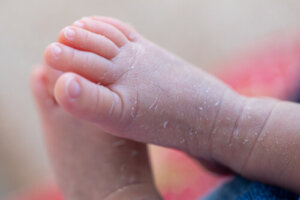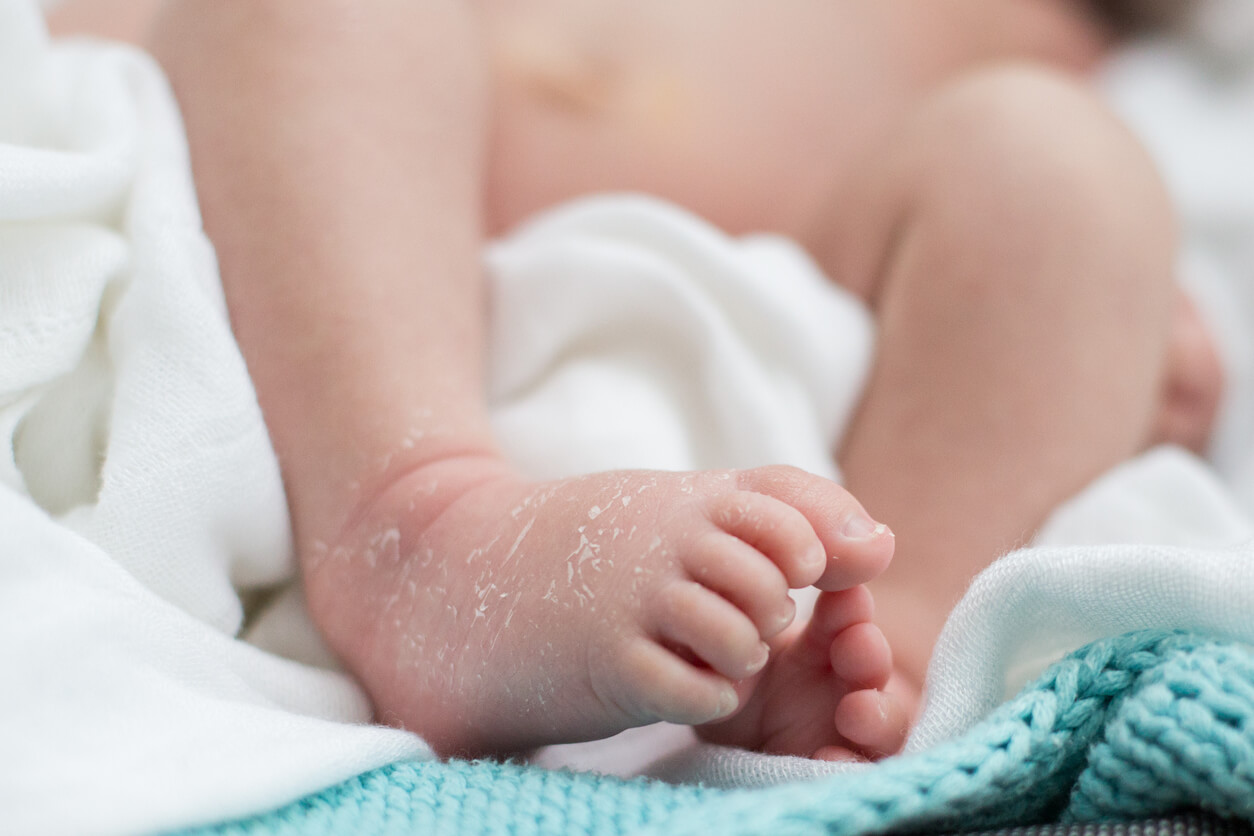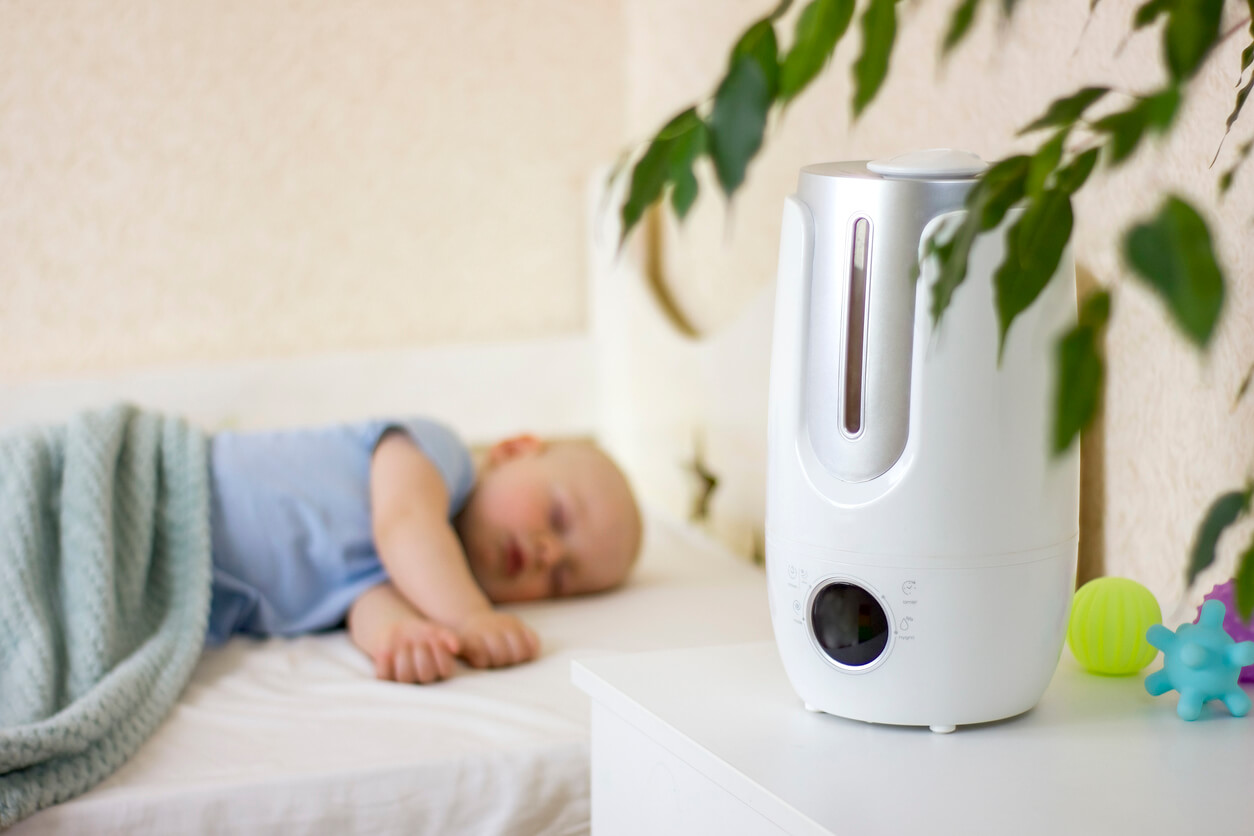The Causes of Flaky Skin in Babies


Written and verified by the dermatologist Maria del Carmen Hernandez
Babies’ skin is smooth, soft, pleasant-smelling, and sensitive. For this reason, it’s very vulnerable to flaking, especially in the winter months. However, there’s no need to worry about it, but rather to take proper care of it so that it remains nourished and functional. In this article, we’ll tell you what causes flaky skin in babies and how to prevent it.
What causes a baby’s skin to flake?
In most cases, the same factors that dry out adults’ skin will cause dryness in babies’ skin. Therefore, exposure to dry air and cold temperatures, such as in the winter, can decrease the skin surface’s own moisture and humidity.
Even hot baths or being immersed in water for prolonged periods of time can weaken the skin’s moisture, even if it’s a pleasant and relaxing activity. All of this, coupled with the delicate and thin epidermis of newborns, predisposes babies to flaky skin.
The appearance of flaky skin in babies
When a baby’s skin is dry and needs more moisture, it may show subtle flaking, roughness to the touch, or cracks and fine lines. In addition, this condition occurs most often on the hands, lips, face, and feet. In general, if the scaling is mild, it won’t cause significant discomfort to the child. On the other hand, if the skin’s too dry, it can be itchy, which encourages scratching and irritation of the area.
According to the American Academy of Dermatology Association, the goals for managing dry skin are as follows:
- Eliminate symptoms such as itching.
- Teach hygiene and care measures to prevent itching.
- Restore the skin’s protective barrier function.

Eczema in infants
Eczema’s a skin condition that often occurs in infants from the first months of life. It can present signs similar to dry skin. It’s always best to go to the doctor’s office so that the specialist can make the correct diagnosis, but there are some concrete differences to be able to distinguish them:
- Unlike dry skin, which appears scaly or rough, in the presence of eczema, it appears red or pink, according to the degree of inflammation. Also, tiny vesicles may appear in the area.
- While dry skin and eczema can occur on the hands, face, feet, and lips, the latter is more common on the scalp, behind the ears, or in the creases of the knees and elbows.
- Eczema isn’t only aggravated by weather or baths, but also by humidity, rough fabrics, dust, and certain detergents or soaps.
Read more: My Baby Has Reactive Skin
Measures to prevent a baby’s skin from flaking
There are several simple measures to prevent flaky skin and dryness in babies’ delicate and sensitive skin. Check them out below.
Take short baths with lukewarm water
Prolonged baths with hot water tend to strip the skin surface of its own moisture. Therefore, it’s best to keep them short, with lukewarm water, and the use of soaps that don’t contain too many chemicals. In addition, it’s advisable not to bathe your baby every day. At the same time, when drying, you shouldn’t rub too much with the towel, but pat gently. Afterward, it’s best to apply a moisturizing cream to keep the skin hydrated and soft.
Moisturize the skin daily and constantly
The application of moisturizing cream is one of the most important measures to maintain a healthy, nourished, and functional skin surface. The ideal emollient cream is hypoallergenic and doesn’t contain fragrances, chemicals, or perfumes. In addition to applying it after bathing, the procedure should be repeated throughout the day and all over the body.
You may be interested in: What Are Those Little Red Spots on My Baby’s Skin?

Use a humidifier
According to studies published by Pediatric Dermatology, newborns tend to have drier skin than usual. For this reason, it’s a good idea to add a cool mist humidifier to the environment to achieve more humidity, as warm air’s usually drier. At the same time, it’s not a good idea to overheat the rooms where the baby is.
Choose neutral and gentle cosmetic products
The skin of newborns is delicate and not yet fully developed. Therefore, the ability to act as a protective barrier isn’t yet active. Consequently, the choice of the type of oil or soap is important in order not to alter the pH values of the skin surface. Neutral, mild soaps that don’t generate too much foam and don’t contain perfume are recommended.
Constant moisturizing is essential
Newborn skin is more delicate and sensitive, as its definitive development hasn’t yet been completed. Therefore, certain hygiene and care processes are required to keep it healthy. It’s best to ensure the moisturization and integrity of the skin surface to prevent possible eczema and flaking.
All cited sources were thoroughly reviewed by our team to ensure their quality, reliability, currency, and validity. The bibliography of this article was considered reliable and of academic or scientific accuracy.
- Telofski LS, Morello AP 3rd, Mack Correa MC, Stamatas GN. The infant skin barrier: can we preserve, protect, and enhance the barrier? Dermatol Res Pract. 2012;2012:198789. doi: 10.1155/2012/198789. Epub 2012 Sep 4. PMID: 22988452; PMCID: PMC3439947.
- Saijo S, Tagami H. Dry skin of newborn infants: functional analysis of the stratum corneum. Pediatr Dermatol. 1991 Jun;8(2):155-9. doi: 10.1111/j.1525-1470.1991.tb00308.x. PMID: 1923986.
- Lund C. Bathing and Beyond: Current Bathing Controversies for Newborn Infants. Adv Neonatal Care. 2016 Oct;16 Suppl 5S:S13-S20. doi: 10.1097/ANC.0000000000000336. PMID: 27676109.
- Dry skin: Diagnosis and treatment. [Internet] Disponible en: https://www.aad.org/public/diseases/a-z/dry-skin-treatment
This text is provided for informational purposes only and does not replace consultation with a professional. If in doubt, consult your specialist.
